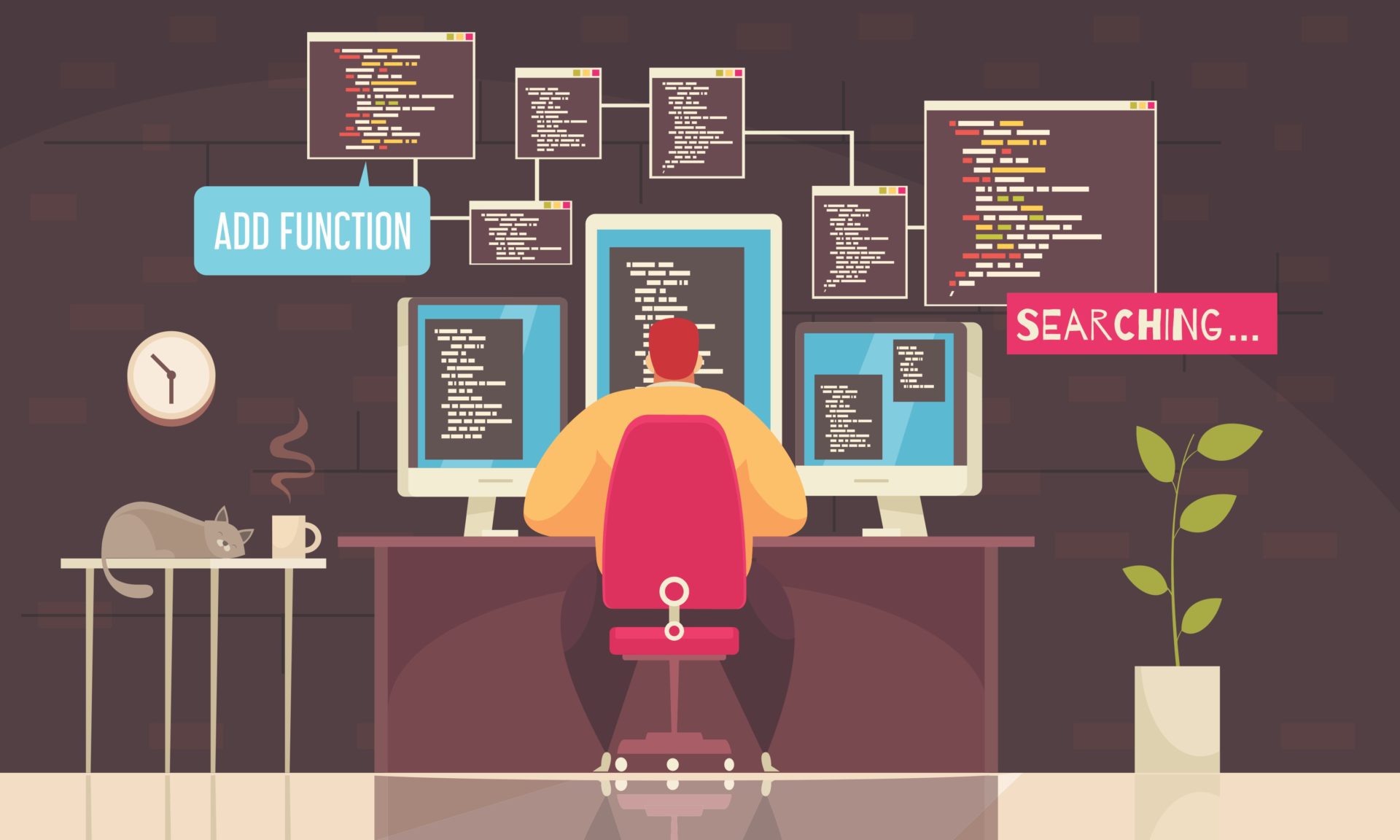
Let’s face it: walking into a conversation among a group of software developers can feel like entering a foreign country. They—and other IT professionals—have a language all their own. While in most cases you might rely upon a polite smile and nod to get you through the parts that are over your head, that’s far from acceptable practice when you’re hiring someone into one of these roles.
Never fear, non-techie recruiter, because we’ve got your pocket dictionary of IT terminology right here! We’ve broken down a range of technical terms by category. Use it as a guide during the tech recruiting process to help determine whether a candidate and their skills are up to snuff, even if their skillset and background are well outside of your wheelhouse.
IT Terminology Glossary
IT roles
Front-end developer: A type of computer programmer who develops applications and interfaces that a user interacts, typically using programming languages like HTML, CSS, and JavaScript.
Back-end developer: A type of computer programmer who builds the technology that powers front-end functionality using languages like PHP, Ruby, and Python and tools like MySQL, Oracle, and SQL Server.
Full-stack developer: A developer with skills in both server- and client-side development, i.e. the “full stack” of development capabilities.
UI designer: UI stands for user interface. This designer works to make the user interface of an application simple and functional.
UX designer: UX stands for user experience. This designer works improve the customer experience by increasing ease of use and enjoyability of an application.
System administrator: This person is responsible for the maintenance, operation and reliability of an organization’s computer systems, with a primary focus on servers.
Network administrator: This person is responsible for the reliable operation of an organization’s networks, a.k.a. the means by which multiple computers or applications communicate with one another.
DevOps engineer: Bridges the gap between development and business operations, particularly during code releases. They help streamline communication and collaboration during software development, QA, testing and deployment.
SecOps engineer: Designs and oversees systems that secure and protect the organization’s networks, applications and data. Screens and tests the organization’s defenses in order to identify and fix vulnerabilities.
Data architect: Responsible for designing, deploying and managing the means by which an organization’s data is stored, consumed and used.
Cloud architect: Designs and manages computing strategies specifically within a cloud environment. Helps companies select the appropriate cloud infrastructure and applications to support business needs.
Data scientist: Helps companies collect, analyze, visualize and interpret data sets to make informed decisions. Works closely with business leaders to understand and achieve business goals.
SRE: Site reliability engineer. This person is responsible for the effective development, maintenance and operation of a software or system.
ERP manager: Oversees a company’s enterprise resource planning (ERP) activities, which includes the software a company uses to support business functions like accounting, project management, manufacturing, supply chain, and human resources.
General industry terms
DevOps: Short for development and operations. This describes a specific approach to software development based on integration and communication between software development, QA and IT teams. It’s useful for releasing and optimizing new features quickly.
Agile: An approach to software development in which software is built, deployed and refined in increments rather than all at once. It’s user-centric and encourages swift and flexible response to feedback.
Waterfall: The predecessor of Agile. An approach to software development in which each carefully planned and documented phase must be fully completed before the next phase can begin. Testing and optimization only happen once the full scope of development is complete.
Scrum: A management framework that outlines a series of tools, meetings and roles for efficiency product delivery. Teams use scrum to self-manage and continuously adapt.
Kanban: Pronounced “KAHN-bahn.” A system that helps development teams visualize their work. Work is represented on a kanban board, which allows team members to see the status of any piece of work at any given time.
Big data: The term used to describe the massive and ever-growing volume of data that can be used strategically to improve business outcomes.
Cloud computing: The delivery of software and other technical services over the internet (i.e. “the cloud”) versus via a download on a local machine.
Algorithm: A set of rules, similar to a set of instructions, a computer follows when performing operations.
Scalability: The ability of a system or network to accommodate growth.
Open source: A term used to describe software whose code is free and available to the public. It is developed by a community for public use rather than by a company for commercial sale.
iOS: A mobile operating system developed by Apple.
Android: A mobile operating system developed by Google.
Framework: A platform for developing software applications. A foundation upon which developers can build programs.
Source code: The instructions that tell a piece of software, website, or application how to work. Source code is written in a programming language like Java, CSS or Ruby.
Database: A collection of information stored and used by software, organized in a way that makes it easily accessible.
Relational database: A database model in which data is stored in tables. Most databases used in modern applications are relational databases.
Version control: In software development, a process for tracking and managing changes made to code. Version control gives developers visibility of who is working on what and enables multiple people to be working on a piece of code at the same time.
Deployment: The process of making an application or piece of software available for people to use.
Continuous delivery: A software development practice in which every change is made releasable, so that a new version of the software could theoretically be released at any time.
Sprint: A length of time dividing the different parts of a project. For example, a team might develop a new feature over a two-week sprint.
Ready to hire better talent?
Connect with our recruiting professionals today.
Programming languages
HTML: Hypertext Markup Language. This code is used for structuring web pages and the content on them.
CSS: Cascading Style Sheets. This programming language directs the visual aspects of a website, like fonts, colors, and spacing, through a series of style sheets.
JavaScript: A programming language that defines the behavior of a website. It can be used to make elements interactive and controls how HTML and CSS elements function.
PHP: Originally stood for Personal Home Pages. This is a scripting language especially useful for developing web pages.
Python: This is a scripting language designed to be easy to read and use. It can be used to create dynamic web content, applications, plugins and 2D and 3D imaging.
Ruby: An object-oriented scripting language designed to make programming easier by making assumptions. In other words, you don’t have to start from scratch with each new project. Ruby is the language used in the Ruby on Rails web application framework.
SQL: Structured Query Language. This programming language is used to access and modify information in a database. It’s used in web database development and management.
C: A general-purpose programming language created in the 1970’s. It’s a procedural language, meaning that it is comprised of a series of steps that must be performed one after the other. It’s one of the simplest programming languages to learn and can be used to write a wide variety of programs.
C++: A more complex, powerful operating language that is useful for developing games, operating systems, and other high-performance computing systems. It’s object-oriented, meaning that its code is organized around objects (pieces of data) rather than functions and logic.
C#: Pronounced “c sharp.” It’s a programming language that’s more complex than C and C++, but also less prone to errors. It’s used to build applications that run in Microsoft’s .NET framework.
Architecture terms
OOP: This is an object-oriented programming methodology for software/application design based on a system of interacting objects. Many commonly used languages are object-oriented, such as Java, Python, and C#.
MVC: Model-view controller. A software/application design model based on three connected parts: the model, which manipulates the data; the view, a.k.a. the user interface; and the controller, which controls the change in the model.
SOA: Service-oriented architecture. An architecture methodology that aims to help a business efficiently add new services. In SOA, application components work with other components via a network.
UML: Unified modeling language. A programming language used to design and construct software systems via object-oriented development.
API: Application programming interface. A set of commands and functions that allow programmers to interact with an external system. This saves them from having to write code that already exists from scratch. The Windows API, for example, gives developers access to UI and elements like windows and scroll bars so they don’t have to create them independently.
Markup: A type of computer language that uses tags to define various elements. It uses standard words (a.k.a. it’s readable by humans) rather than programming syntax. The two most common examples of markup language are HTML and XML.
XML: A markup language that can be used to provide context for a set of data. For example, if you were sending a list of books, you might use XML tags like <Title>, <Author>, and <Publisher> to clarify which lines within the list contain these particular fields.
REST: Stands for representational state transfer. It’s a way of building APIs that allows applications to exchange data in multiple formats, making it easier for different computer systems to communicate with one another.
SOAP: Simple object access protocol. It’s a secure way to build APIs by encoding data in the XML format. A REST API is more flexible than a SOAP API, given that data can be exchanged in various formats.
Skills, tools, and programs
AWS: Amazon web services. A cloud services platform with various functionalities that help developers deploy web applications.
Bootstrap: An open-source web development framework used to build websites incorporating HTML, CSS, and JavaScript. It was developed by team members at Twitter.
jQuery: An open-source JavaScript library. It helps web developers easily add functionality to their websites by referencing a jQuery JavaScript file, rather than writing the code themselves.
MySQL: An open-source relational database management system based on SQL. It’s most commonly used in web servers, but can be used in dynamic web pages that access information from a database.
Git: Pronounced with a hard /g/ sound, like the word ‘get.’ A version control system that stores source code and its development history. It enables teams to track changes, merge code and revert to earlier versions if needed.
GitHub: A software development and code-hosting platform that helps users work together on projects while maintaining version control. GitHub also offers valuable developer resources like code review, discussions and wikis.
Kubernetes: An open-source platform that automates the deployment, scaling, management and maintenance of application containers across a cluster of nodes. It helps developers derive maximum utility from containers and build cloud-native applications that can run anywhere.
Apache: The most popular web server software, released in 1995. It’s open-source and enables a computer to host one or more websites that can be accessed via the internet with a web browser.
Oracle: A relational database management system designed for enterprise grid computing. It helps global enterprises to manage and process information across far-reaching and local networks in a cost-effective way.
AI: Artificial intelligence. A field of study that works to engineer computers that function and reason like humans.
Machine learning: An artificial intelligence skill set involving algorithms that enable a computer to learn and adapt over time rather than following a set of static code.
Get Help from the Tech Recruiting Experts
Are you overwhelmed by the stack of IT applications on your desk? Are you not sure how to select a candidate who will actually be able to accomplish what you need? 4 Corner Resources can help. Our team of information technology staffing professionals can help you sort through the tech speak and identify talent with the experience you need to get the job done.
In today’s business world, your technology can make or break your ability to grow. You need an IT team that’s agile, adaptable, and innovative, able to help you apply the latest technology to solve your problems and serve your customers. We’ll deliver top-tier talent with these skills to your door. Contact us to start sourcing qualified, motivated professionals in your field today.


